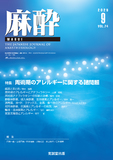Japanese
English
- 有料閲覧
- Abstract 文献概要
- 1ページ目 Look Inside
- 参考文献 Reference
はじめに
世界中で毎年約2億3千万人の患者が手術のための麻酔を受けており,手術に関連して700万人が重度の合併症を発症している1)。2010年の “麻酔科学における患者安全に関するヘルシンキ宣言” において,周術期のアナフィラキシーは合併症を減らすために対応が必要な事象の一つとして位置づけられた1)。手術室で行う麻酔は,薬物やモニターの進歩によって近年安全性が飛躍的に向上しているものの,アナフィラキシーは予測不可能で重篤な病態であり麻酔科医にとって脅威となっている。
日本麻酔科学会は,2015年にヘルシンキ宣言に調印したあとにアナフィラキシーへの対応について検討を始め,2021年に “周術期アナフィラキシーへの対応プラクティカルガイド” を出版した2)。これを契機に麻酔科医のアナフィラキシーへの対応の質は徐々に向上しているように感じる。しかし,周術期アナフィラキシーの診断,治療,原因の同定には未解決の課題が残されており,そうした課題の解決策についての私見も以下に述べる。
著者らは2019年から2020年にかけて全国規模の前向き観察研究(Japanese Epidemiologic Study for Perioperative Anaphylaxis:JESPA)を行い,日本で周術期に発生するアナフィラキシーの実態を調査した3)4)。本論文では周術期のアレルギーとアナフィラキシーについてJESPAの結果を交えながら解説する。
Anesthesia is used for the surgery of approx. 230 million patients each year worldwide, and approx. 7 million of these surgeries involve severe complications. Perioperative anaphylaxis remains a critical surgery-related challenge due to its unpredictable and potentially fatal nature. In response, the Japanese Society of Anesthesiologists(JSA)published the Practical Guide for Perioperative Anaphylaxis Management in 2021, seeking to improve clinical responses to anaphylaxis.
The Japanese Epidemiologic Study for Perioperative Anaphylaxis(JESPA)investigated the incidence and causative agents of perioperative anaphylaxis in Japan. Its results indicated that the drugs which are the most frequently involved in cases of perioperative anaphylaxis are rocuronium, cefazolin, and sugammadex. The symptoms that are commonly observed in patients with perioperative anaphylaxis are hypotension, bronchospasm, and skin manifestations, but there is individual variability in organ involvement that remains unexplained.
A significant challenge in Japan is the lack of insurance coverage for key diagnostic tests for perioperative anaphylaxis, such as serum tryptase measurement. The shortage of specialists in drug-induced anaphylaxis also contributes to the difficulty in achieving an accurate diagnosis. The JSA encourages anesthesiologists to perform skin testing for better causative identification. Alternative neuromuscular blocking agents(NMBAs)are not approved for use in Japan, and this also limits management options. Future efforts should focus on revising national guidelines, expanding access to diagnostic testing, and introducing alternative NMBAs in order to improve the management of perioperative anaphylaxis.

Copyright © 2025 KOKUSEIDO CO., LTD. All Rights Reserved.


